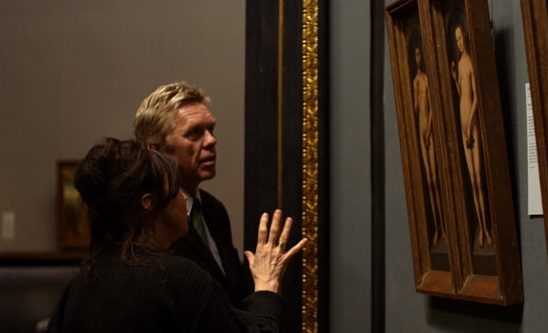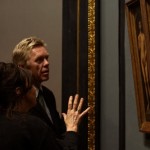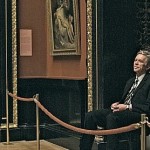“The real voyage of discovery lies in not seeing new landscapes but in having new eyes” – Marcel Proust
Jem Cohen’s Museum Hours moves art beyond the confines of a stuffy museum and takes it out into the streets of Vienna where its profound observations make irrelevant the artificial distinction between art and life. Cohen widens our view of what is “inside” the museum to include what is “outside,” not as a separate part of the experience but as an integrated whole. The film is narrated by Johann (Bobby Sommer), a soft-spoken museum guard at the Kunsthistorisches Museum in Vienna who, after spending his younger days traveling with rock bands, has worked at the museum for the past six years, getting to know each painting intimately. His favorite room is the Bruegel room where Flemish Renaissance painter Pieter Bruegel’s depictions of 16th century peasant life touch him most deeply.
Having just arrived from Montreal to visit her cousin who is in a coma, Anne (Mary Margaret O’Hara) seeks advice from Johann about directions to the hospital. As the two talk about the city, they develop a friendship and he acts as her tour guide, escorting her to visit ancient and modern sites in Vienna. As the experience opens him to a renewed appreciation of the city and its history, the camera focuses its attention on city life in a way that allows us to notice details that we may have never seen before: Young boys on skateboards in the park, an old woman walking up a hill flanked by red cars, the walls of an ancient church, abandoned beer cans on the sidewalk, the faces of pedestrians huddled in the cold waiting for a bus, the boarded-up storefront of a store, and the give and take of bargaining at a local flea market.
Johann and Anne also spend time in the hospital where they talk to Anne’s cousin who cannot hear them. Johann describes in details some of the paintings of Rembrandt from memory “all very dark and wise-looking,” while Anne sings her a lovely ballad. The narrative of the woman and her cousin develops slowly but Museum Hours is not about the story, but about observation and our connection with the world. One of the film’s highlights is the discussion of Bruegel by the tour guide (Ela Piplits) talking to a group of eager visitors. According to the guide, in a time of political repression carried out by the Duke of Alba, Bruegel’s paintings were radical, “more radical than they might seem.”
Dressing as a peasant to immerse himself in the culture of the poorer classes, Bruegel’s depiction of the masses was not judgmental but focused on the small details of peasant life. As the director puts it, “This man (Breugel) took a very close, careful look at how working people, peasants lived and did it without a sentimental overlay, but with a respectful interest in the details of their lives.” Another moving part of Johann’s narration is his story about one of his coworkers, an art student who is no longer at the museum. As Johann tells us, the kid, whom he calls a “Marxist punk,” ridiculed the idea of a museum, saying it is all about money and that the still-lifes of famous artists are the equivalent of piles of Rolex watches, champagne bottles, and flat-screen TVs.
Though Johann obviously disagrees with this assessment, he does not put the student down, dismiss his objections, or find the need to offer a defense. Museum Hours is a riveting experience that bonds us to a world of stillness, beyond the limits of our sense perception. The film helps us to see with new eyes, enabling us to move towards a deeper, more truthful experience of ourselves and the world, one in which a young black boy in a hoodie is as rare and beautiful as a Rembrandt.






'Movie Review: Museum Hours (2012)' has no comments